Written by Meg and Zhao Qirui

"The long-term scale of the global stablecoin market is projected to reach $1.4 trillion to $3.7 trillion, with US dollar stablecoins holding a dominant position. Against this backdrop, Yuanbi Technology's success isn't measured by a global market share of hundreds of billions of dollars. Its true target market is to leverage a foreseeable, multi-billion dollar market segment in scenarios such as cross-border trade in the Greater Bay Area, RWA, and RMB internationalization."
1. Introduction
With the implementation of the regulatory regime for stablecoin issuers under the Stablecoin Regulation on August 1, 2025, the issuance of fiat-denominated stablecoins has become a regulated activity requiring a license. Meanwhile, on July 30, 2025, RD Technologies successfully completed nearly $40 million in Series A2 funding, led by ZhongAn International, Zhongwan International, Brilliant Investment, and Hivemind Capital, with participation from Sequoia China and others. This round follows a $7.8 million Series A1 round in September 2024, demonstrating investor confidence in RD Technologies' vision of driving digital currency trading and asset tokenization with secure, enterprise-grade stablecoin infrastructure.
How does Yuanbi Technology stand out amidst favorable policies and market competition? Let's explore this from financial, legal, and commercial perspectives.
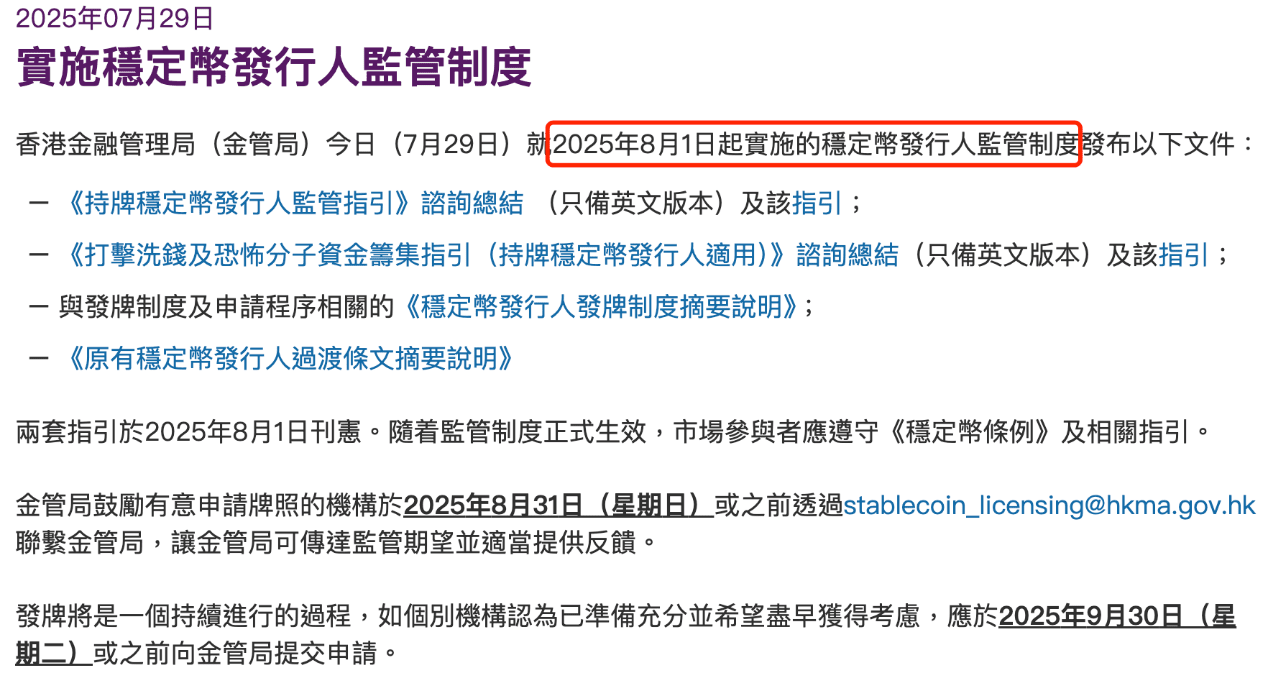
2. Yuanbi: Technology Overview + Financing Background
Yuanbi Technology was founded in 2021 by former Chief Executive of the Hong Kong Monetary Authority, Norman Chan. Its shareholders include HashKey, ZhongAn International, Sequoia China, etc. It has the advantages of integrating Web3 and traditional finance.
Financing Background: Details of the A2 round: US$40 million, led by ZhongAn International, Zhongwan International, Brilliant Investment, and Hivemind Capital, with participation from Sequoia China and others. The funds will be used to expand platform capabilities and prepare for regulatory compliance.
This is a round of A2 financing with a strong lineup of investors. One of the lead investors, ZhongAn International, is also an active participant in the Web3 track. The Hong Kong (Stablecoin Ordinance) that came into effect on August 1, 2025 provides a clear regulatory framework for the issuance of stablecoins, and ZhongAn Bank actively participates in this process.
ZhongAn International and ZhongAn Bank, both part of ZhongAn Online, collaborate to promote the development of the crypto industry, focusing on technology investment and compliant financial services, respectively. ZhongAn International is investing in Web3 through investments in projects like Yuanbi Technology, while ZhongAn Bank provides payment and compliance support, jointly supporting the development and application of HKDR.
3. Hong Kong Stablecoin Policy and Market Opportunities
The Hong Kong Legislative Council passed the (Stablecoin Bill) on May 21, marking the official establishment of a licensing system for fiat stablecoin issuers in Hong Kong.
Internationally, stablecoin legislation is also accelerating. The US Senate passed a key procedural vote on the "Guiding and Establishing a National Stablecoin Innovation Act" on May 20, and legislation is likely to be finalized before the end of the year. On May 27, the UK released regulatory proposals for stablecoin issuance, crypto asset custody, and the financial soundness of crypto asset companies. In March, Japan detailed regulatory adjustments for crypto assets and stablecoins.
As of August 3, 2025, the HKMA has not yet issued any stablecoin licenses. The HKMA adopts a high threshold, strict oversight, and steady progress approach to stablecoin licensing. Initially, it expects to issue a single-digit number of licenses (approximately 3-5), with the first batch expected to be issued in early 2026. The regulatory framework emphasizes financial stability and anti-money laundering, while also accommodating innovation. However, high compliance costs and a cautious pace may limit short-term market activity.
However, the regulatory intensity and requirements are currently quite stringent. The licensing requirements for stablecoins are as follows:
Any institution issuing a fiat-denominated stablecoin in Hong Kong, or a stablecoin claiming to be pegged to the Hong Kong dollar, must apply for a license from the HKMA.
The applicant must be a company registered in Hong Kong or an overseas "approved institution" and meet high capital and financial requirements, such as paid-in capital of not less than the prescribed amount
Stablecoins must be backed by highly liquid assets of equal value (such as Hong Kong dollar cash, short-term bonds or US dollar deposits, US Treasury bonds). Reserve assets must be segregated and subject to independent audits. Algorithmic stablecoins are prohibited.
Licensed institutions must comply with anti-money laundering and terrorist financing guidelines, deploy smart contracts to enable real-time transaction monitoring, and ensure the security of customer assets.
In other words, if a fiat stablecoin is issued in Hong Kong or a project claims to be pegged to the Hong Kong dollar, it must apply for a license; otherwise, it will be considered illegal. The registration requirement is either Hong Kong or an overseas "recognized institution." Based on current market trends, companies seeking stablecoin licenses in Hong Kong prefer to register in Hong Kong, as they are concerned that future policy changes in third countries will affect their business development.
Stablecoin issuers' high compliance requirements, including their requirements for underlying asset liquidity, are, to some extent, a "business moat." RD Technologies, one of the first participants in the Hong Kong Monetary Authority's "Stablecoin Issuer Sandbox," has entered the testing phase and plans to issue HKDR on the Ethereum public blockchain. ZhongAn Bank is collaborating with RD Technologies to test a stablecoin, HKDR, backed by Hong Kong dollar reserves.
ZhongAn International's VASP license and ZhongAn Bank's virtual banking license form a closed-loop compliance system, meeting the Hong Kong Monetary Authority's stringent requirements for stablecoin issuers (reserve asset transparency and regular audits) and virtual asset services. YuanBi Technology, leveraging ZhongAn Bank's virtual banking license and payment system, provides technical and compliance support. The bank's cross-border payment and retail settlement businesses can provide application scenarios for the HKDR.
As an international financial center, Hong Kong's position as a hub for the Greater Bay Area, its stringent stablecoin regulatory framework, and the stability of the Hong Kong dollar offer advantages for the development of Hong Kong dollar stablecoins. Hong Kong dollar stablecoins can reduce costs and improve efficiency in cross-border trade, and they hold great potential, particularly within the Greater Bay Area and in the context of RMB internationalization. However, retail payment applications are limited by the size of the local market and rely on cross-border consumer adoption. Compared to US dollar stablecoins, Hong Kong dollar stablecoins offer advantages in compliance and localization in the Asia-Pacific region. However, global competition is limited by market size and acceptance, and in the short term, they will primarily focus on regional expansion.
Promising Future: While US dollar stablecoins (such as USDT and USDC) currently hold over 90% of the global stablecoin market (as of August 3, 2025, the global stablecoin market capitalization is approximately US$250 billion, with USDT accounting for approximately 60%), the market size of Hong Kong dollar stablecoins is limited by the Hong Kong dollar's circulation (approximately HK$400 billion, or approximately US$50 billion). However, Hong Kong dollar stablecoins have local advantages in the Asia-Pacific region, particularly in the Greater Bay Area and countries along the Belt and Road Initiative. They can be combined with RMB tokenization to attract markets seeking to reduce their reliance on the US dollar (such as Southeast Asia and the Middle East), creating differentiated competition in specific scenarios.
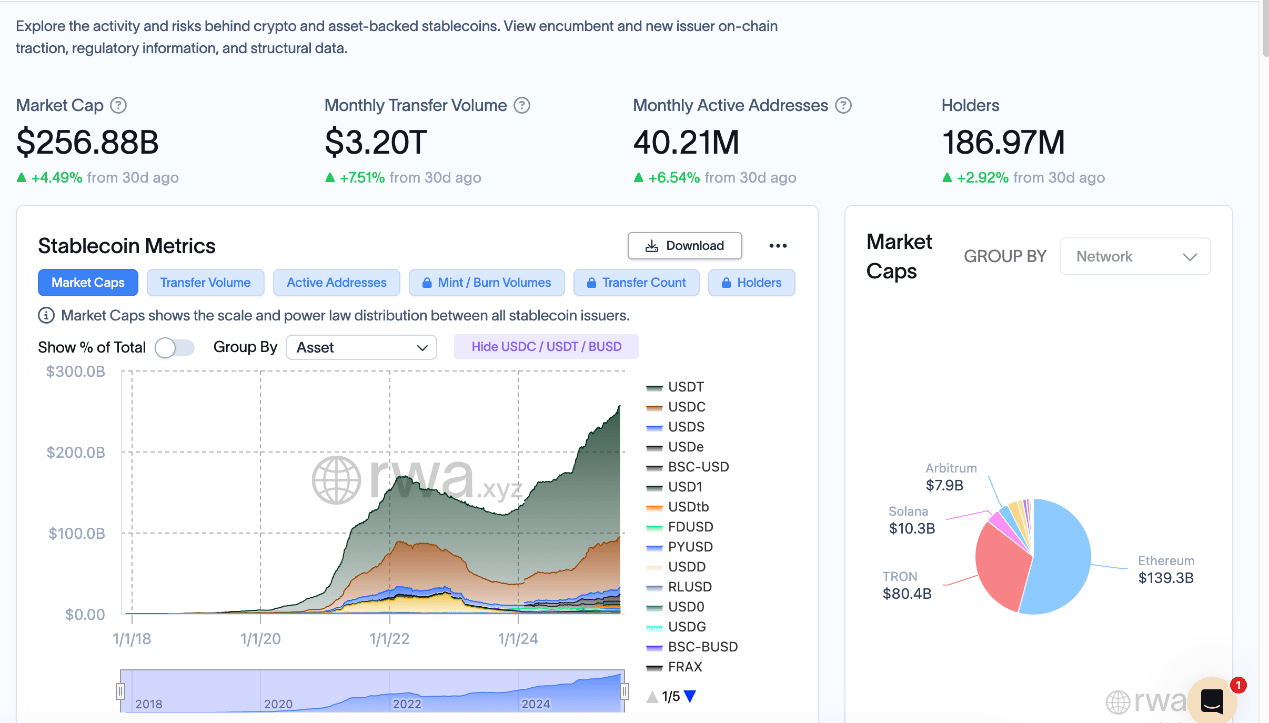
Data source: https://app.rwa.xyz/stablecoins
4. Yuanbi: Business Model + Competitive Advantage
We compare the financial data of the US stablecoin company Circle to illustrate the opportunities of Circle Technology.

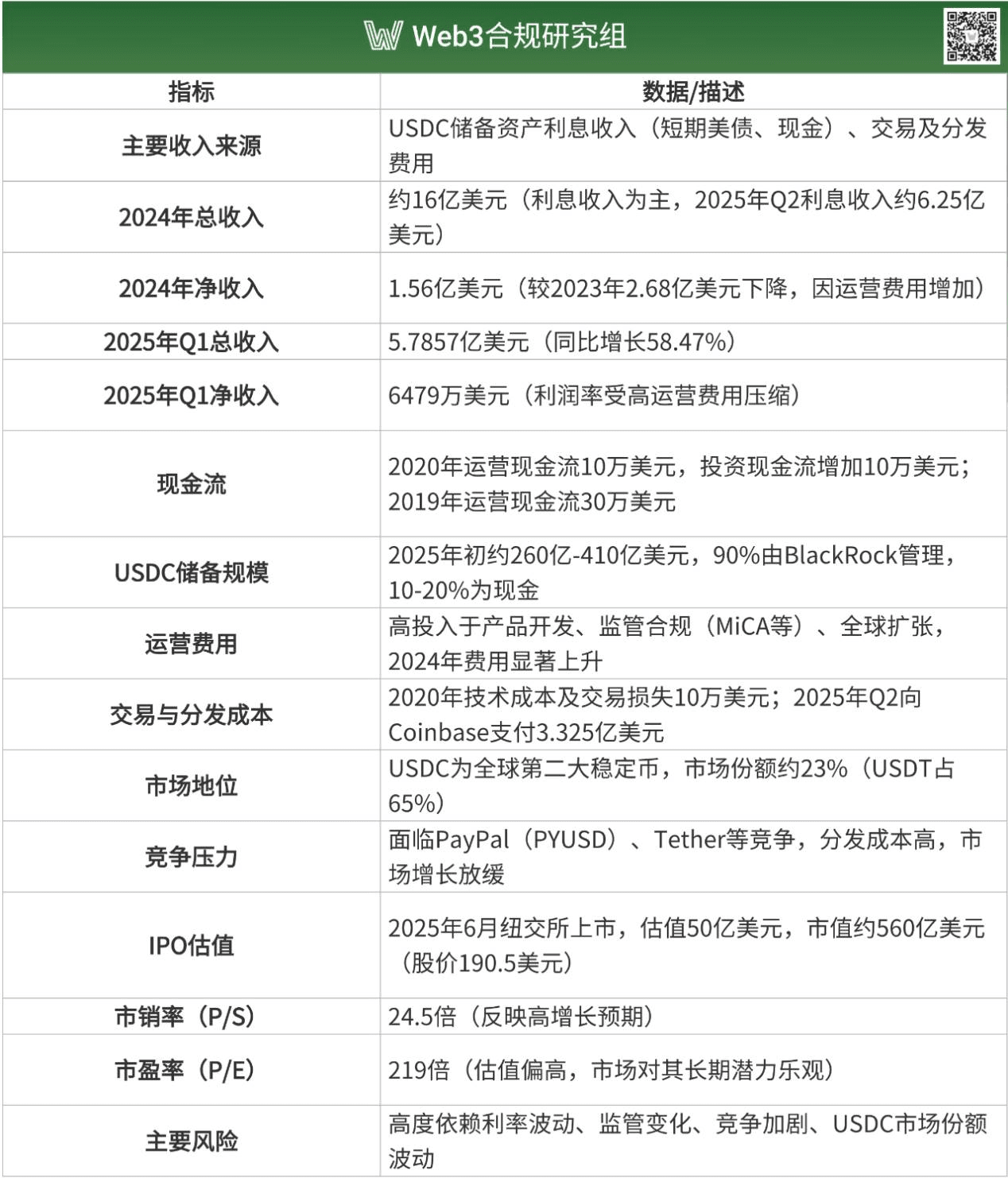
The business model of stablecoin issuers is simple, easily understood by almost everyone, but not everyone can execute it. It disrupts the traditional banking model of loan-to-deposit margins (gross profit = loan interest income - deposit interest expenses). Stablecoin issuers' gross profit = interest income - channel costs (or marketing costs).
Currently, retail investors or users receive zero interest income and do not receive dividends from the interest income from the stablecoin issuer's purchase of US Treasury bonds. Clearly, stablecoins currently have much higher profit margins than traditional banks! Circle (USDC issuer) expects a net profit of $156 million in 2024, 99% of which comes from interest on its reserves.
Yuanbi Technology focuses on cross-border payments, using blockchain technology to achieve near-real-time settlement (clearing in seconds, compared to 1-3 days for traditional banks). It automates the transaction process through smart contracts, reducing intermediaries. It is said to increase efficiency by 100 times and reduce costs by 90% (estimated using the table below).
Traditional Banks vs. Yuanbi Technology: Cross-border Payment Costs and Efficiency
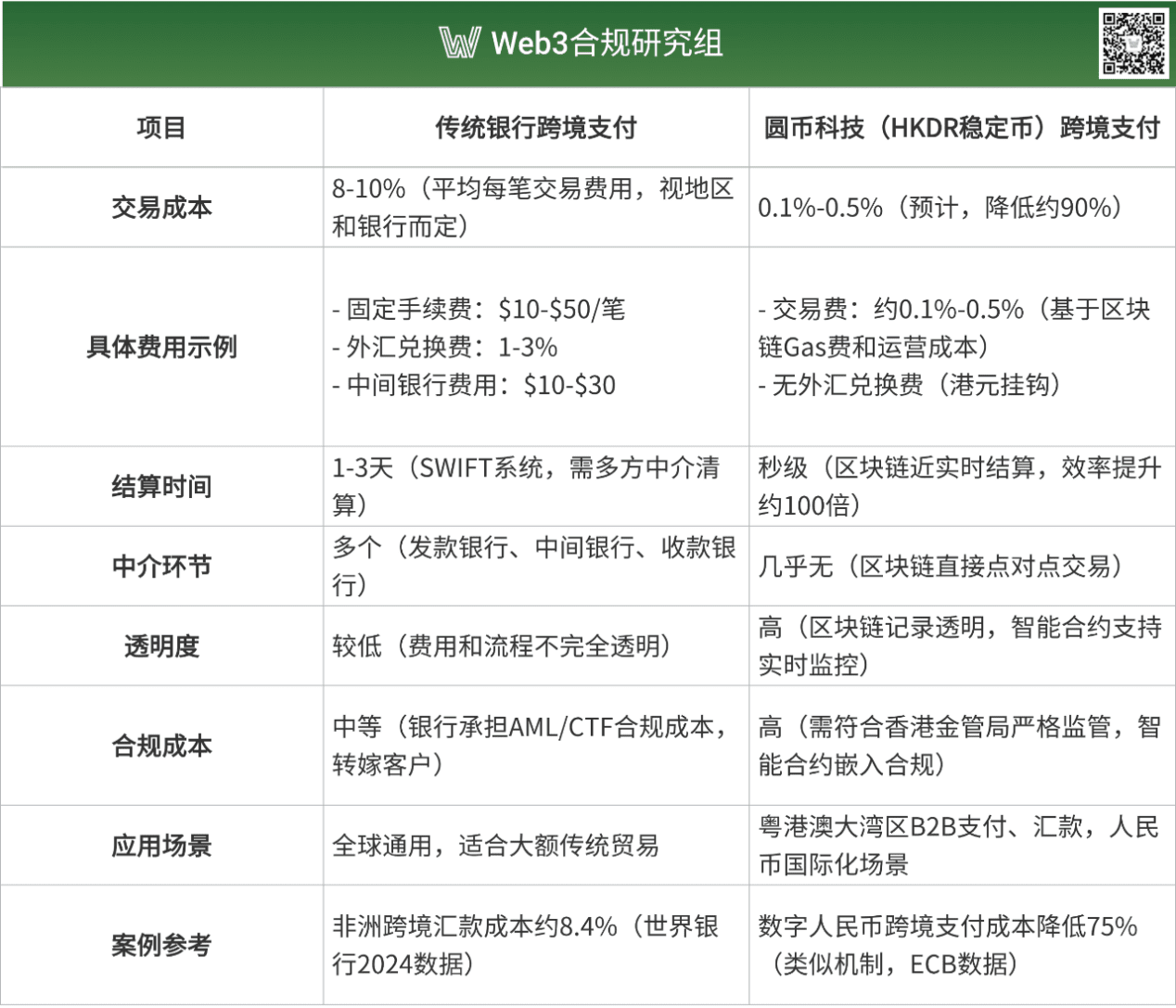
Yuanbi Technology counts HashKey (a licensed exchange) and ZhongAn International (with payment experience) as shareholders. It focuses on bridging the Web3 ecosystem with traditional finance, offering a more flexible positioning. Its strategic partnership with ZhongAn Bank enhances its ecosystem integration capabilities. JD.com's JD-HKD, backed by the e-commerce giant's application scenarios, focuses on retail and cross-border payments, each with its own strengths.
5. Challenges + Risks
RD Technologies' development journey isn't a series of isolated challenges, but rather a systemic dilemma woven together by compliance, competition, technology, and geopolitical risks. Its core challenge lies in the fact that the compliance barriers it must erect to survive are being internalized as high operating costs, directly undermining its competitiveness amidst the swarm of giants. The technology choices it's forced to make, in turn, create new performance-cost conflicts. Ultimately, all of this is constrained by structural pressures in the global macroeconomy.
(1) As a compliance shackle that cannot be externalized
Hong Kong's regulatory framework provides Circle Coin with a foundation of legitimacy, but this foundation comes at the cost of heavy, unpassable costs. This cost is like a custom-made suit of heavy armor, which provides protection but also severely restricts its agility.
First, compliance translates directly into financial pressure and strategic rigidity. The requirement for paid-in capital of HK$25 million and a 100% reserve of high-quality liquid assets means that a significant amount of capital is locked up before a product can achieve scaled revenue. This is not only a financial burden but also a direct stifle to strategic flexibility. During a critical window of opportunity requiring rapid iteration, market education, and user acquisition, this capital lock-up will hinder a company's ability to compete with well-funded giants.
Secondly, compliance comes at the expense of efficiency, creating an inherent friction with the product's core value. Regulators require all stablecoin transactions to go through regulated exchanges and impose additional risk controls on non-custodial wallets. While this design minimizes money laundering risks, it also blunts the inherent advantages of blockchain technology: low cost and high efficiency. When compliance processes hinder the experience in cross-border payments, its primary use case, resulting in a subpar experience, "compliance" can become a hindrance rather than a boost to market adoption.
(2) The shadow of giants covers the current market
The pressure of compliance costs is further magnified by fierce market competition. The stablecoin market has evolved from a crypto-native game into a fiercely competitive arena dominated by giants and financial institutions. Yuanbi Technology faces not only the challenge of breaking the existing landscape but also the challenge of fending off the dimensionality-reducing attacks of new giants.
The gravitational pull of US dollar stablecoins: US dollar stablecoins, led by USDT and USDC, have developed a powerful network effect. Their deep liquidity, widespread protocol integration, and ingrained user habits create an insurmountable barrier to entry. For Yuanbi Technology, this means HKDR must offer significant additional incentives to convince users to switch, which will undoubtedly continue to erode its already slim profit margins.
The dimensionality-reducing attack from emerging giants: The real threat to survival comes from the entry of tech giants (such as JD.com and Ant) and traditional financial institutions (such as Standard Chartered Bank). The former boasts vast user bases, established payment networks, and ample capital, enabling them to rapidly seize market share through subsidy wars and scenario-based bundling. The latter, however, possesses a natural trust and vast corporate client base. Once their stablecoins are launched, they will easily acquire B2B clients with the highest compliance requirements, rendering Yuanbi Technology's "compliance" advantage less exclusive.
To provide a clearer picture of this competitive landscape, the following table summarizes the specific threats posed by major rivals:
Main competitors
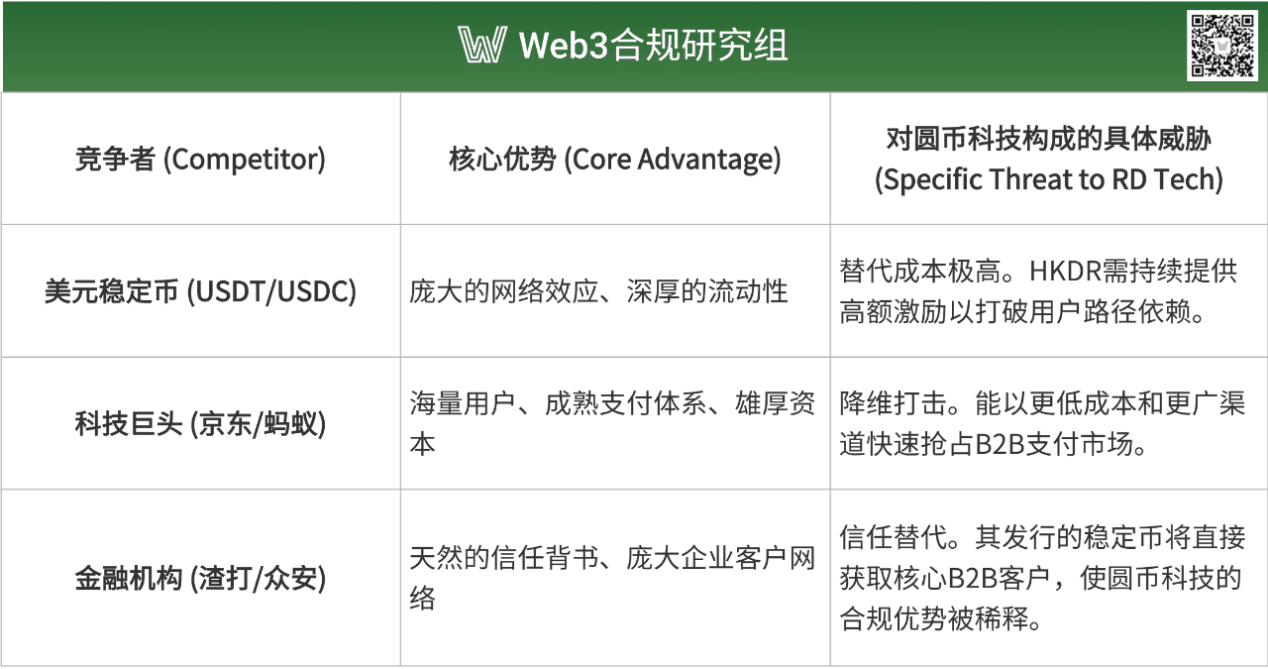
3. Difficult Technology Choices
Under the dual pressures of compliance and competition, Yuanbi Technology's technological path—issuing HKDR on the Ethereum public blockchain—presents a new dilemma. This strategic decision, intended to connect to a vast ecosystem, has created an inherent and difficult-to-reconcile contradiction within the core use case of B2B payments.
This presents a real-world dilemma: Ethereum's decentralization and security come at the expense of scalability. Its network congestion and fluctuating gas fees run counter to the core goals of cross-border trade: low cost, high efficiency, and high stability.
While Layer 2 solutions are seen as a potential solution, they represent a trade-off between replacing old problems with new ones. While alleviating performance bottlenecks, they introduce new challenges such as cross-chain bridge security risks, technical stack complexity, and liquidity fragmentation. This increases technical architecture maintenance costs and operational risks, potentially impacting user experience. Once liquidity, the lifeblood of stablecoins, is fragmented due to technical complexity, its ability to withstand the risk of depegging is also weakened.
4. The invisible hand of geo-economics
Finally, all of these challenges are woven into the powerful gravitational field of global geopolitics and macroeconomics. These structural forces have created invisible boundaries for the survival of non-USD stablecoins.
The US dollar's digital hegemony is being consolidated: The US is accelerating the incorporation of stablecoin legislation into its financial regulatory system. One of its strategic objectives is to transform stablecoin issuers into new "super buyers" of US Treasury bonds. Every expansion of US dollar-denominated stablecoins objectively consolidates the dollar's digital hegemony, creating a structural squeeze on all non-US dollar stablecoins, including the Hong Kong dollar.
Realistic ceilings for RMB internationalization: Despite significant potential, the development of offshore RMB (CNH) stablecoins remains constrained in the short term by the "glass ceiling" of China's capital account openness and the lack of depth in the offshore market. This directly limits Yuanbi Technology's potential for future development in the larger narrative of RMB stablecoins.
Systemic risk awareness of "shadow banking": Regulators view stablecoins as a "new type of shadow banking" and remain highly vigilant about the systemic risks they may trigger. This vigilance will ultimately translate into stricter and more detailed regulatory requirements, trapping Yuanbi Technology in a spiral of "risk concerns -> increased regulation -> rising compliance costs," creating an inescapable negative feedback loop.
VI. Looking to the Future
Market predictions for stablecoins:
2030: Citi predicts the market could grow 14-fold to $3.7 trillion, driven by regulatory clarity and institutional adoption. Sei Network predicts the market will reach $1.4 trillion.
2035: MetaTech Insights expects the global stablecoin market to grow from $182.6 billion in 2024 to $1.1068 trillion, with a compound annual growth rate (CAGR) of approximately 17.8%, primarily driven by Ethereum-based stablecoins and multi-chain/second-layer solutions.
CBDC and Stablecoin Market: It is estimated that by 2034, the total market value of central bank digital currency (CBDC) and stablecoin market will grow from US$66.4 billion in 2025 to US$151.3 billion, with a CAGR of 9.58%.
The global stablecoin market is projected to grow to $300 billion to $400 billion by 2025, and could reach $1.4 trillion to $3.7 trillion in the long term (2030-2035), or even exceed $1 trillion. USD-denominated stablecoins will dominate the market. While the Hong Kong dollar-denominated stablecoin market will be relatively small in the short term (few billion dollars), it has growth potential in the Greater Bay Area cross-border trade and RMB internationalization scenarios, potentially reaching tens of billions of dollars in the long term. Market growth will be driven by regulatory clarity, cross-border payment demand, and technological advancement, but regulatory differences and infrastructure challenges must be overcome.
As a stablecoin issuer, Yuanbi Technology's future prospects can be reflected in the following aspects:
Short-term goals: Complete sandbox testing, obtain a Hong Kong stablecoin issuance license, launch HKDR, and expand cross-border payment and Web3 use cases.
Long-term Vision: Hong Kong, a major global financial center known as Asia's Wall Street, is projected to have a stablecoin market exceeding $1 trillion. Circle Coin Technology is poised to play a key role in Hong Kong's Web 3.0 ecosystem. Furthermore, Hong Kong's second digital asset policy declaration will promote the integration of traditional finance and blockchain, providing Circle Coin Technology with more room for innovation.
Yuanbi Technology's future is likely to be a journey from "license value" to "implementation of specific scenarios." Its success or failure will not depend on whether it can follow macro trends, but rather on whether it can transform compliance, a core asset, into an irreplaceable competitive advantage in specific niche markets within a strict regulatory framework.
(I) Strategic cornerstone: Compliance licenses as core assets
The Hong Kong Monetary Authority's stablecoin license is the cornerstone and core asset of Yuanbi Technology's entire strategy. Amidst tightening global digital asset regulation, this license's value far exceeds mere approval; it serves as a powerful "trust anchor." It effectively distinguishes Yuanbi Technology from the numerous non-compliant, gray area projects in the market, paving the crucial first mile for Yuanbi Technology to attract risk-sensitive institutional clients and traditional financial partners.
Obtaining the license means that Yuanbi Technology can transform its huge investment in reserve management, transaction monitoring, anti-money laundering (AML), etc. from "compliance costs" into "market credibility." This credibility is its ticket to enter the high-value B2B payment and real-world asset (RWA) scenarios.
(II) From a Trillion-Dollar Blue Ocean to Niche Market Dominance
The global stablecoin market is heading towards a trillion-dollar market. Citigroup predicts the market could reach $3.7 trillion by 2030, while MetaTech Insights predicts it will exceed $1.1 trillion by 2035, representing a compound annual growth rate of 17.8%. However, for Yuanbi Technology, this trillion-dollar market, dominated by US dollar stablecoins, presents both an opportunity and a warning.
All-out competition is like hitting a rock with an egg. Its only viable strategy is to abandon the fantasy of "becoming the next USDT" in this huge market and instead pursue "niche market dominance."
Cross-border trade: Hong Kong's multi-trillion-dollar B2B payment volume provides ample depth for the HKDR. Yuanbi Technology's focus isn't on competing with giants like JD.com and Ant, but rather on targeting specific customer segments underserved by traditional banks—for example, the 40% of small and medium-sized enterprises (SMEs) that are often shut out by higher account opening thresholds. By providing more flexible, efficient, and compliant payment solutions, Yuanbi aims to establish a foothold in these niche sectors, such as specialized commodity trade and SMEs expanding internationally.
Cryptocurrency Trading: The licensed exchange under its shareholder, HashKey Group, provides HKDR with valuable initial liquidity and application scenarios. This ensures HKDR's usability from the outset. However, the long-term challenge lies in expanding beyond the HashKey ecosystem and listing on Hong Kong's other ten licensed platforms, avoiding becoming a "circulating" token on a single platform and building a true network effect.
RWA Closed Loop: I believe that RWA is the ultimate application scenario for stablecoins, with HKDR playing a key role in the "on-chain funding" infrastructure. Once assets are tokenized, equally compliant and efficient on-chain funding is required to complete the value loop. Yuanbi Technology's challenge lies not in creating RWA assets, but in establishing deep partnerships with asset issuers (such as new energy projects) and tokenization platforms to ensure a steady supply of high-quality assets that can be matched with HKDR, creating a seamless "asset on-chain, capital online" connection.
(III) Overview of Strategic Cooperation
Yuanbi Technology's strategic partnership network is the core weapon in executing its niche strategy. The value of these partnerships lies not in the memorandums themselves, but in whether they can be transformed into sustained business flows and ecological barriers.
Core Partner Values and Challenges
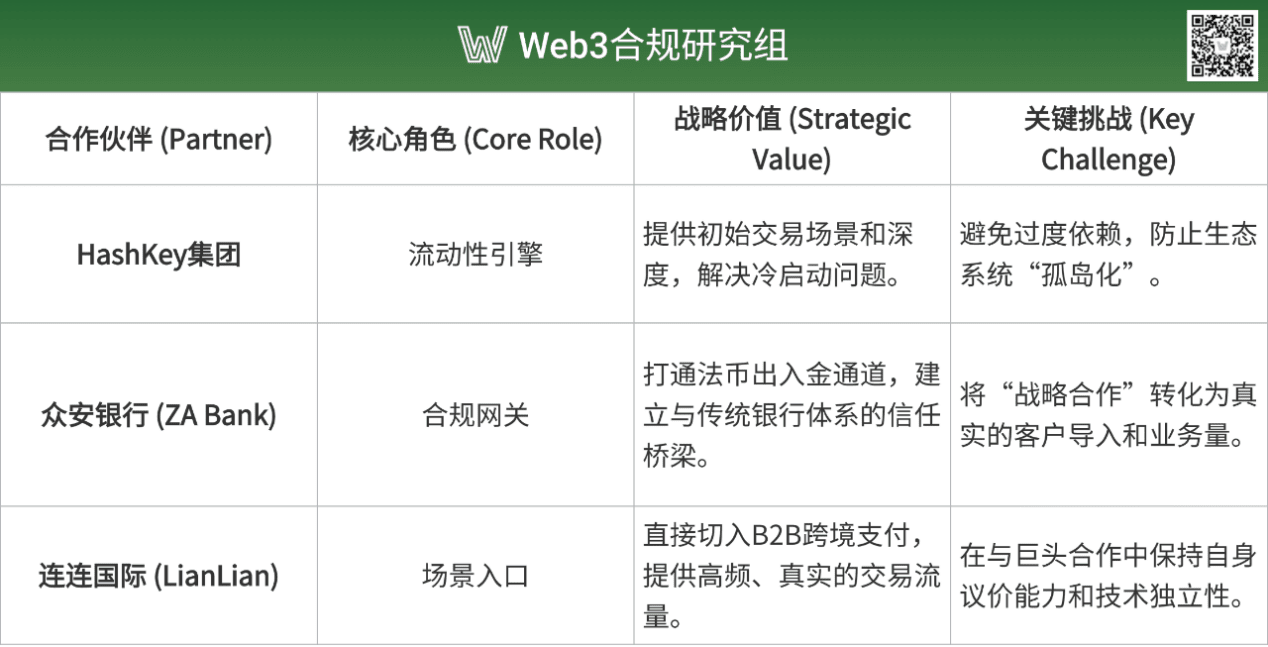
The future of Yuanbi Technology will be tested by its ability to transform its heavy "compliance armor" into an unstoppable competitive sword in niche markets through precise strategic choices and efficient ecosystem collaboration. This is not only a challenge for Yuanbi Technology alone, but also crucial for whether the Hong Kong stablecoin ecosystem can find its place in global competition.
VII. Conclusion
Yuanbi Technology's practice is not only a strategic positioning for Hong Kong in the accelerated global stablecoin competition with "compliance certainty" as its core product, but also a key test to test whether non-US dollar fiat stablecoins can find a living space in the highly regulated, US dollar-dominated digital financial system.
The core strategic paradox facing Circle Coin Technology is that the stringent compliance barriers upon which it relies—including a 1:1 reserve peg, a prohibition on fractional reserve models, clear redemption rights, and a strict anti-money laundering (AML)/counter-terrorism financing (CFT) framework—while simultaneously lending it legitimacy and a rare endorsement of trust, can also become the heaviest hurdle in its pursuit of catching up with market pioneers. Translating this "compliance bonus" into a true "market advantage" rather than a "hindering innovation" is the fundamental challenge for the scalable development of Circle Coin Technology and the entire Hong Kong stablecoin ecosystem. This requires achieving a unified approach of efficiency, scale, and compliance in core application scenarios such as cross-border payments, virtual asset trading, and RWA.
In the second half of the stablecoin era, the nature of competition has shifted from the early, "wildly growing" battles for technology and market share to a delicate dance of compliance and ecosystem development within a strict legal framework. As one of the first participants in the Hong Kong Monetary Authority's "Sandbox" for stablecoin issuers, Yuanbi Technology's progress will profoundly reveal how to achieve a dynamic balance between innovation and sovereign oversight as Web3 shifts from "decentralized" exploration to "compliant integration."
The global stablecoin market is projected to reach between $1.4 trillion and $3.7 trillion in the long term, with US dollar-denominated stablecoins expected to dominate. Against this backdrop, Yuanbi Technology's success isn't measured by a global market share of hundreds of billions of dollars. Its true target market is to leverage a foreseeable, multi-billion dollar market segment within scenarios such as cross-border trade in the Greater Bay Area, RWA, and RMB internationalization.
Hong Kong’s strict regulatory policy is a double-edged sword. In the short term, it increases costs and limits the speed of some innovations, but in the long run, it creates a highly certain business environment and isolates the risk of “bad money driving out good money”.
Looking ahead, the explorations of Yuanbi Technology and similar institutions will force the global financial market to reconsider: As the digital economy enters its "virtual zenith," how will true financial innovation find a viable path to coexist between the globalized, borderless Web3 trend and the increasingly stringent compliance requirements of sovereign states? Will the "shackled" compliance pilot program lead the way, or will the gray area of "regulatory arbitrage" remain a hotbed of innovation?
